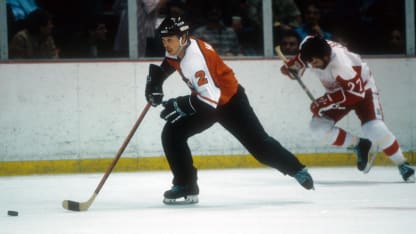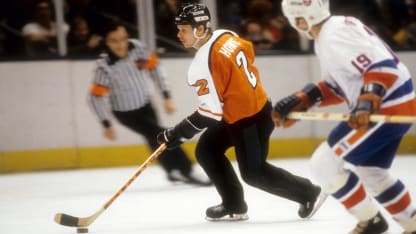"I had to cut the backs of them a little bit so I could get my stride," he said. "It restricted my stride, stretching out to get going. … We could cut the backs of the girdle and the inside part of the pants. You could cut it so you could stretch and get more stride.
"I found where my hamstrings were sore at [training] camp when we first started wearing these things because it restricted your whole stride. But once we made the adjustments there they were a little bit better."
Another issue came when players would fall.
"If you ever fell you gained speed with the nylon long pants," Barber said. "You didn't have any grab on the ice. You picked up speed, not slowed down."
Holmgren said, "Not like we blocked shots like players do today, but if you went down to slide to block a shot wearing those things, you slid a lot further. You'd slide yourself right out of position. So there was some getting used to it in that regard."
Whatever issues the players had wearing them, it didn't affect the Flyers in the standings. The Flyers made the Stanley Cup Playoffs in the two seasons they wore the Cooperalls, including finishing first in the Patrick Division in 1982-83.
But it was the eye test the Cooperalls failed. The Flyers were only team to wear them in 1981-82. The Hartford Whalers joined the next season, wearing full-length green pants in 1982-83.
"I don't know you could term it, if it was weird or whatever," Barber said. "But you wondered if it belonged in hockey."
After the second season of Cooperalls, the NHL banned them, and the Flyers and Whalers went back to wearing traditional hockey pants.
"I was ready to go back to the other ones," Barber said. "Something you wore all your life, there was no adjustments necessary with the old equipment. These things you had to [adjust to]. I was kind of glad to get back to the original pants, the way hockey should be."
The Flyers will be sporting Cooperalls during warmups for each of the eight games they wear their 2022-23 Reverse Retro jerseys. See the full Reverse Retro schedule below:
- Tuesday, November 8 vs. St. Louis Blues
- Wednesday, November 23 at Washington Capitals
- Friday, November 25 vs. Pittsburgh Penguins | NHL Thanksgiving Showdown
- Thursday, December 1 vs. Tampa Bay Lightning | 80s Throwback Thursday
- Thursday, December 15 at New Jersey Devils
- Thursday, January 5 vs. Arizona Coyotes | 90s Throwback Thursday
- Saturday, January 14 at Washington Capitals
- Thursday, January 19 vs. Chicago Blackhawks | 2000s Throwback Thursday



